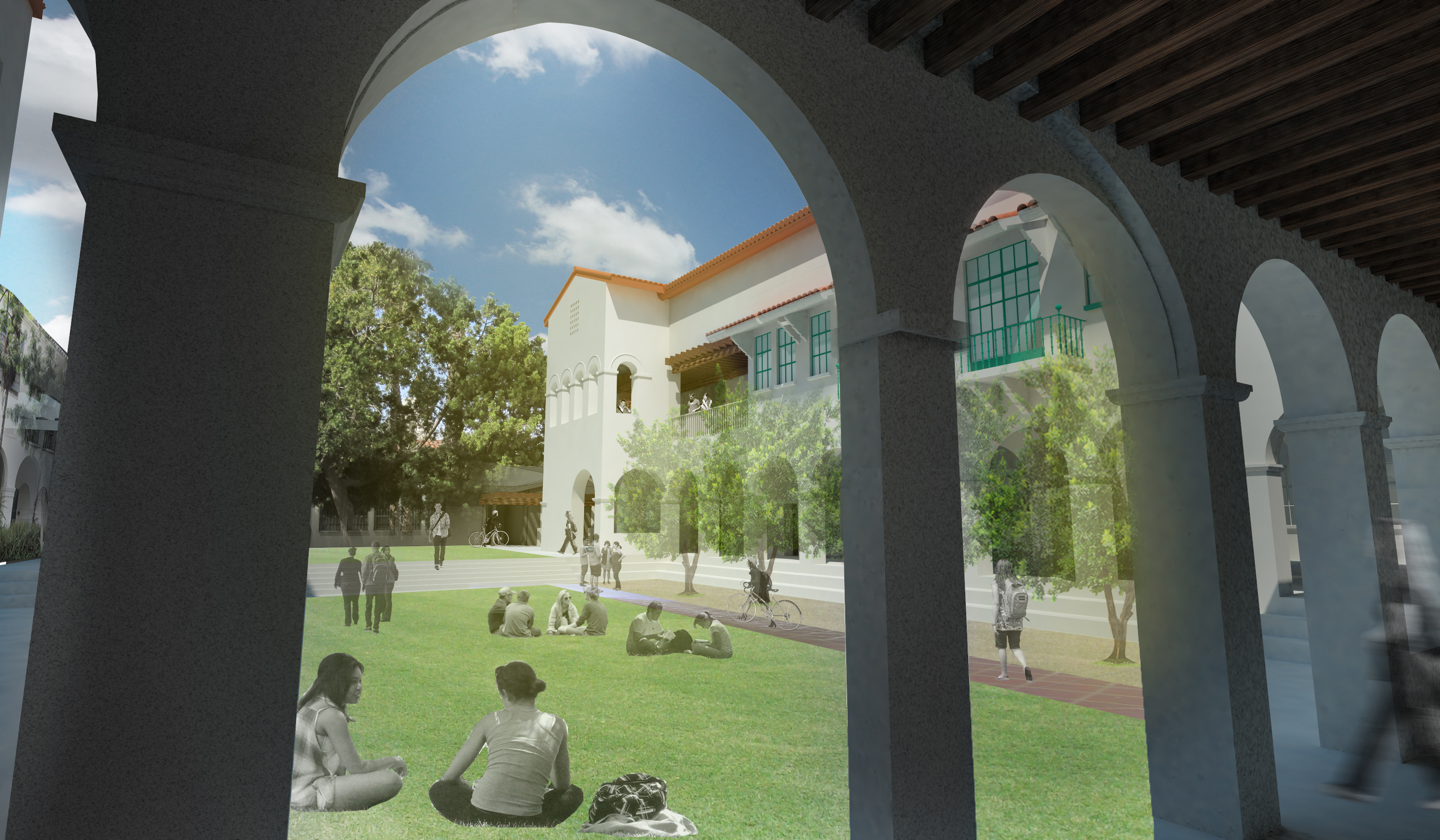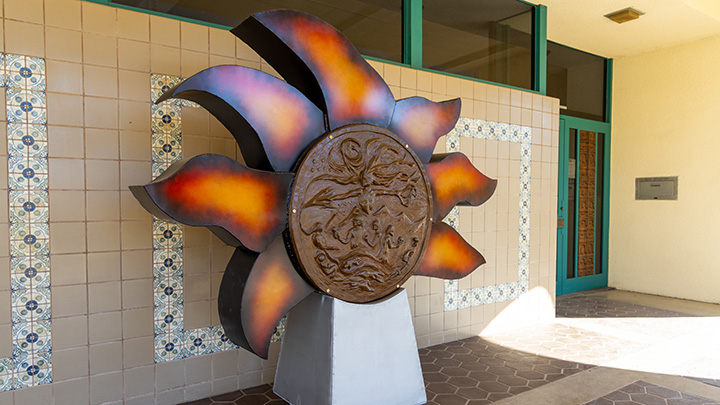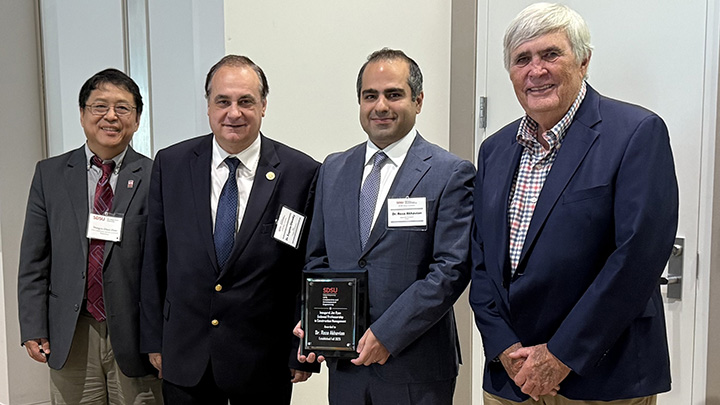Collaborative Collisions
SDSU's Engineering and Interdisciplinary Sciences Complex will develop real-world applications for research discoveries.

“If you’re in a building that’s buzzing with energy and creativity, you buzz with it.”
This story appears in the summer 2015 issue of 360: The Magazine of San Diego State University.
The great ideas of the future — the ones that might cure devastating diseases or address our world’s looming climate woes — won’t be devised by brilliant, solitary thinkers. Instead, they will emerge from the intellectual collisions of research teams, from alliances between engineers and biologists or mathematicians and climate scientists.
Interdisciplinary research is the future, and SDSU is ready to go there.
“The problems that face our country and our world are quite large and complicated,” according to Stephen Welter, vice president for research and dean of Graduate Affairs. “It’s apparent that the solutions can’t come from a singular discipline. But when you put bright, engaged people next to one another and let them find common ground organically, you get unpredicted positive outcomes.”
Creating fertile ground for these fortuitous partnerships is the primary motivation behind SDSU’s newest project, the Engineering and Interdisciplinary Sciences (EIS) Complex, scheduled for completion in 2018. In addition to cutting-edge labs and working spaces, the complex will also provide new, state-of-the-art classrooms, allowing SDSU’s science and engineering programs to cultivate the problem-solvers of tomorrow.
“SDSU has a long tradition of providing the kind of hands-on experience that has turned San Diego into a hotspot for biotechnology, cyber-technology, and other kinds of high technology,” explained Stanley Maloy, SDSU's dean of the College of Sciences. “The EIS Complex will expand opportunities for our students to lead future development in these areas.”
Drive to the top
The EIS Complex is a key piece in SDSU’s drive to become a top-50 public research university. Not only will it enhance the university’s current teaching and research capacities, it will also boost SDSU’s ability to attract the best and brightest researchers and graduate students.
“The new complex will help us recruit outstanding faculty, larger numbers of honors students and highly qualified grad students,” said Morteza Mehrabadi, dean of the SDSU College of Engineering. “You cannot be a leading public research university without state-of-the-art facilities like the EIS Complex.”
The complex will host several established research centers including the Viromics Institute, the Smart Health Institute, and an imaging laboratory for brain research. Other research areas will include biomedical engineering, renewable energy systems and wireless communication, with more directions to be identified as planning for the building evolves.
A common theme among these projects will be engineers and scientists recognizing opportunities for taking research and transforming it into real-world solutions. Biomedicine is a perfect example of this, Maloy said. There’s a real need for antibiotics that can target specific, harmful microbes while bypassing our body’s helpful bacterial life. Knowing which microbes are harmful is a science problem, while scaling up the ability to efficiently screen for these microbes in hospitals and clinics across the world is a job for engineers.
Market research
To help bring collaboratively-developed products to market, the EIS Complex will house the William E. Leonhard Entrepreneurship Center, an umbrella for the Zahn Innovation Center and Lavin Entrepreneurship Center.
“The EIS complex will create a crossroads for the STEM disciplines and a focal point for our entrepreneurship efforts—a place to meet, to team up and to dream,” said SDSU President Elliot Hirshman. “These opportunities will elevate the level of teaching and research throughout the university.”
Having scientific research, engineering know-how and entrepreneurship and prototyping expertise all under the same roof will make the EIS Complex a unique and powerful hub for problem-solving, Maloy said.
“You can develop the greatest idea, but if you don’t turn it into a business, it’s going to die,” he said.
Early exposure to entrepreneurial thinking will teach students to instinctively consider marketing opportunities for their discoveries, Mehrabadi said. The complex will feature a student innovation center to mentor them and further their ambitions.
Open concept
With an open, modular floor plan, the building’s workspace will flow seamlessly between labs, offices and common space. There will be mobile furniture, glass walls, a coffee shop and communal whiteboards in the hallways for spur-of-the-moment brainstorming.
The Thomas B. Day Quad, named after SDSU’s research-driven sixth president, will tie these elements together by providing a place for students and researchers to gather and bump into one another — a literal collision course for sparking new ideas.
Mehrabadi imagines engineering students displaying their capstone projects in the quad, then popping over to the Zahn or Lavin centers to discuss consumer interest surveys and scale-up production.
Welter believes this “big tent” approach to research, innovation and entrepreneurship will spur collaboration and creativity across all of the university’s research enterprises.

“If you’re in a building that’s buzzing with energy and creativity, you buzz with it,” he said.
Visit SDSU.edu/EIS for more information about the EIS Complex.



